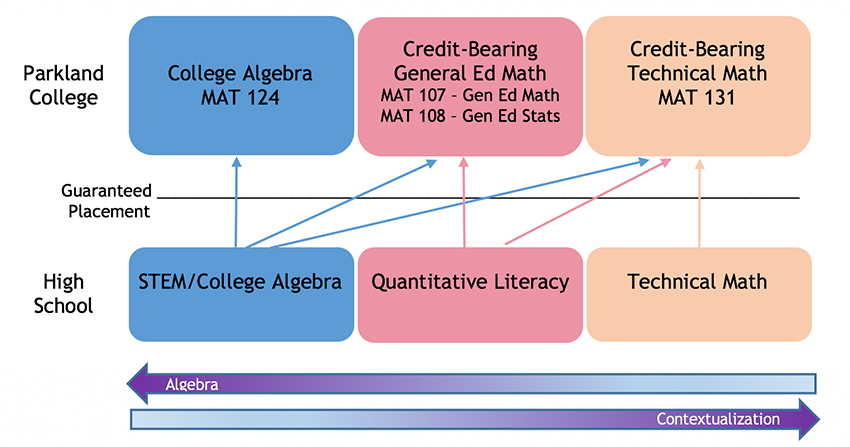What is Transitional Math?
The Postsecondary and Workforce Readiness Act (PWR Act) includes Transitional Math (TM), which is built around courses, standalone or embedded, that increase college readiness for high school seniors. Their key feature is the guaranteed placement a student receives upon successful completion at all Illinois community colleges and accepting Illinois universities. Community colleges and high schools work in partnership to create courses that incorporate the required competencies and policies. These courses emphasize authentic learning experiences aligned with careers as well as a student’s life and future coursework. The goal is to provide high school seniors with a new experience that is motivating as well as valuable in respect to the college placement achieved. Visit PWR Transitional Math for more information.
How many Transitional Math Pathways are there and what are they?
There are three Transitional Math Pathways: Transition to STEM, Transition to Quantitative Literacy/Statistics, and Transition to Technical Math. The chart below shows the placement options for each pathway.

Who is eligible to take Transitional Math?
Transitional math courses are designed for seniors who have met the high school math graduation requirements but who are not projected to be ready for college-level math be the end of their senior year.
Note: The Technical math course is intended only for students who are taking career-oriented coursework while in high school and intend to enroll in a career and technical education program at the community college level that includes a technical math course.
Who can teach Transitional Math classes?
Transitional math teachers must be certified to teach high school math.
EXCEPTION: If the transitional math class is fully integrated with a career/tech program at the high school, then the role of the high school math teacher or community college math instructor must be addressed in the Memo of Understanding, and can range from co-teaching to serving in a resource role when needed.
What does it mean to be college-ready in math?
A high school junior who has successfully completed state math graduation requirements and meets at least two of the following criteria is projected to be ready for college level coursework in mathematics when arriving at a postsecondary institution in Illinois. This determination is conditional based on enrollment in a senior year of math.
- B or better in Algebra 2
- C or better in a course higher than Algebra 2
- GPA of 3.0/4.0
- Standardized assessment: Math SAT or PSAT ≥ 530 or Math ACT >22
- Placement test score (ALEKS) into college-level math at Parkland College
- PARCC math score of 4 or 5
- Teacher and/or advisor recommendation of college-level math in the senior year
A high school junior who has successfully completed state math requirements but has not met at least two of the above criteria will be projected as NOT ready for college-level math and will be given transitional math opportunities.
Which pathway is best for students?
That depends. If you are able to offer all three pathways, then the students need to meet the following minimum criteria for enrollment:
- Transition to STEM – Successfully completed state high school graduation requirement in math and at least one of the following criteria:
• B or better in Algebra I or a higher math course
• Math GPA of 2.5/4 or better
• Teacher verification of transitional college algebra prerequisite competencies
- Transition to Quantitative Literacy/Statistics - Successfully completed state high school graduation requirement in math.
- Transition to Technical Math - Successfully completed state high school graduation requirement in math.
If you are not able to offer all three pathways, you will need to decide which path to offer based on the particular needs and abilities of your student body.
What if a student wants to pursue a different pathway once they get to college?
Students who change to a path requiring more algebra may take a placement test or use alternative options, such as bridge courses or co-requisite courses, to accelerate that change.
What is an MOU?
A Memo of Understanding (MOU) is a document created and signed by both the Community College and the partnering high school that outlines the Transitional Math agreement between the two parties. It should include information on student eligibility, teacher qualifications, rigor and standards, and placement opportunities for Transitional Math courses.
What is the benefit to a student who successfully completes a Transitional Math course?
Students who earn a C or better in a Transitional Math course are eligible to enroll in the applicable college-level math course identified in the chart above without any further placement test or other prerequisite requirement, subject to time limits (see below).
Are there time limits for placement in the college level course?
Enrollment in the applicable college-level math course must occur within 18 months of the transitional math course completion as indicated on the high school transcript. In addition, students who do not enroll in a College-level math course within 6 months of high school graduation may be placed in a co-requisite course alongside their college-level math course.
Is successful placement into a college-level math class only applicable at Parkland College?
Not necessarily. If the Transitional Math course has been approved by the Statewide Portability Panel, then a student who earns a C or better in that course can get placement into the appropriate college-level math course at any community college in Illinois. If the Transitional Math course has not been approved by the Statewide Portability Panel, then college placement will only be allowed at the partnering community college.
Where can I find out more about Transitional Math?
Go to PWR Transitional Math site to find out all the latest information about the PWR Act and Transitional Math in Illinois.